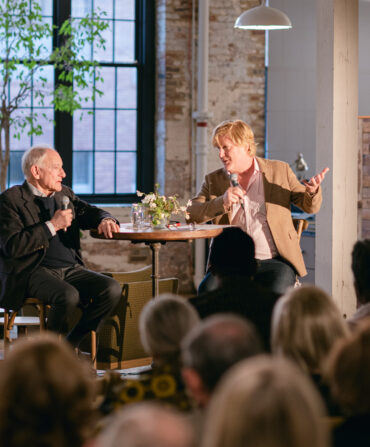Arts & Culture
The Descendants
Montpelier, the Virginia home of President James Madison, has pioneered a bold approach to historical interpretation, thanks to its relationship with a key group: the families of the men and women Madison enslaved
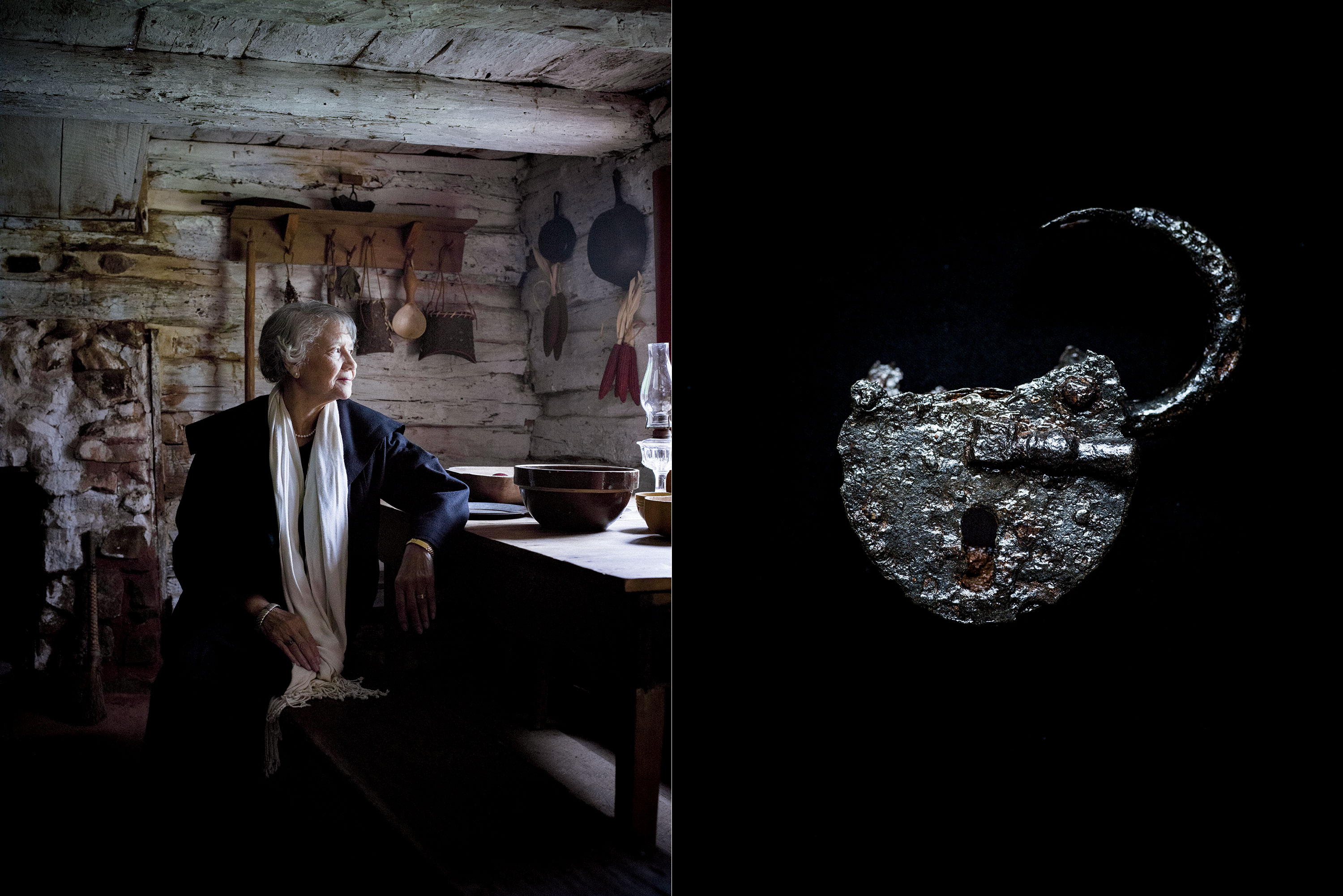
Photo: Bill Phelps
From left: Rebecca Gilmore Coleman in the restored cabin of her great-grandfather George Gilmore, a freedman formerly enslaved by James Madison; A house lock unearthed on an archaeological dig in Montpelier's South Yard, where the domestic slave quarters once stood.
Time had not been kind to the old Gilmore cabin.
Vines and brush crept up and along the crumbling cottage, covering the wood-slat walls and fieldstone chimney. It was 2000, and for decades the structure had sat abandoned across from the mile-long driveway that led to Montpelier, the Virginia estate of the fourth president of the United States, James Madison.
George Gilmore, a farmer, saddler, and carpenter formerly enslaved by Madison, had originally built the home after the Civil War from the remains of Confederate officers’ huts that had been on the property, making payments on the land and eventually obtaining the deed, in 1901. Of Gilmore’s children with his wife, Polly, who were born there, one of the sons begot a son who took his first breath there, too. That son in turn had a daughter, whose married name is Rebecca Gilmore Coleman.
Coleman, a native of the same county, only became aware of the cabin’s existence, however, in the 1970s, when her father pointed it out to her. The Montpelier estate had long since reclaimed the land, and even though the cabin had been modified over the years, the underlying structure remained intact, and that was significant—her great-grandfather’s home was one of the few surviving freedman dwellings in the nation.
By the time the new millennium rolled around, Montpelier itself was coming back to life after more than two centuries in private hands, and Coleman saw her chance. The newly created Montpelier Foundation had just agreed to operate the estate, owned by the National Trust for Historic Preservation, and was raising millions of dollars for the Madison home in the lead-up to the 250th anniversary of the president’s birth, in March 2001. Why, Coleman wondered, shouldn’t they also restore my great-grandfather’s house?
So she asked them. The estate said yes.
“That’s how it all started,” Coleman says. In the eighteen years since, Montpelier has become one of the most inclusive historic estates in the country, a reputation that traces back directly to her request. With the restoration of the Gilmore cabin, Montpelier began to embrace and engage the African Americans who consider the people once enslaved there their ancestors. In turn, that relationship revolutionized the historical interpretation of the estate, helped fund archaeological digs and genealogical discoveries, and inspired and guided the opening last year of reconstructed slave quarters and The Mere Distinction of Colour, a permanent multimedia exhibit that confronts the contradictions and atrocities of slavery. It’s a tribute to Montpelier’s enslaved population that not only radically rethinks traditional interpretation, but also integrates the voices and perspectives of their African American descendants—a group too long excluded from the stories of grand mansions and American presidents.
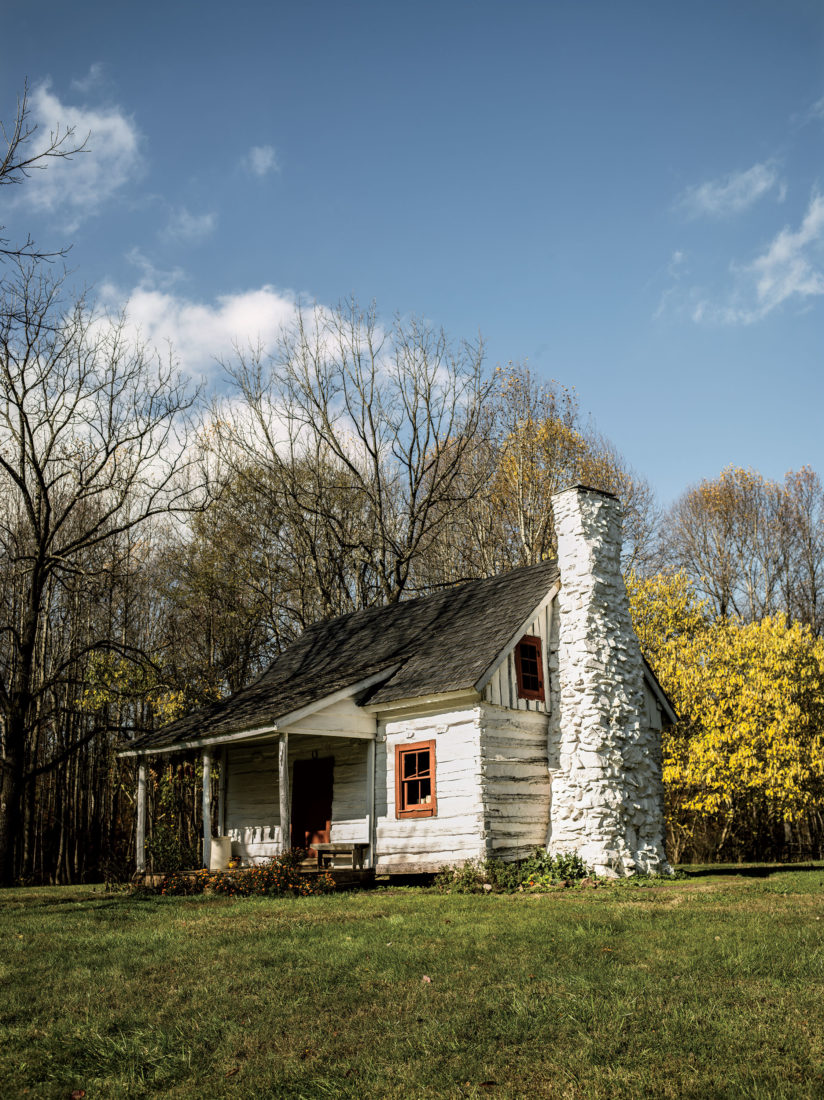
Photo: Bill Phelps
George Gilmore’s cabin.
In truth, Coleman caught Montpelier at precisely the right moment. For much of the twentieth century, the Du Pont family, whose wealth flowed from a gunpowder dynasty that became the chemical and plastics giant, had owned the estate, and had no qualms about altering the historic property. They added thirty-three rooms to the modest layout of Madison’s Georgian-style home, and tinted the stucco—overlaid on the handsome bricks by a previous owner—pink. The heiress Marion du Pont Scott also expanded the grounds with a school and stables; an avid horse breeder and racer, she hosted an annual steeplechase at Montpelier that still goes on today.
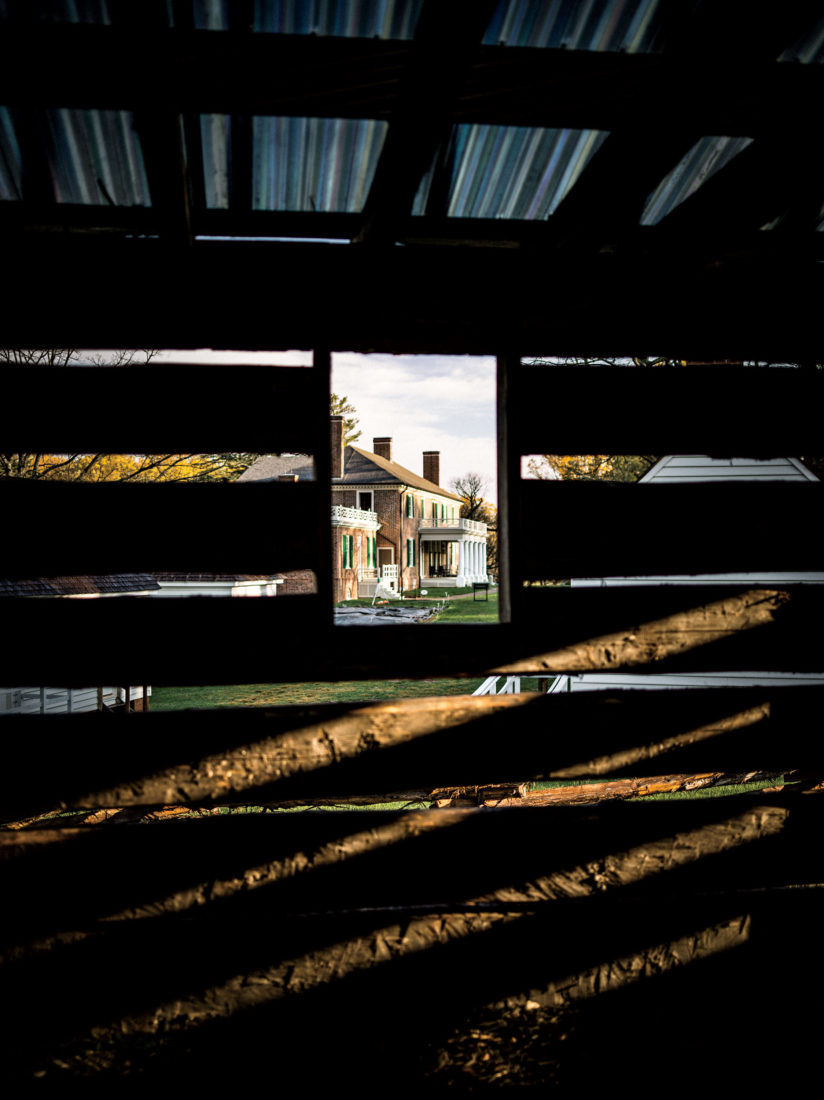
Photo: Bill Phelps
The view of Madison’s Montpelier home, as seen from the reconstructed stables in the South Yard.
James Madison, however, had known a quieter life there. His grandfather Ambrose had been granted the then-2,850-acre tract in 1723, and when the future president inherited the estate, the property included a tobacco plantation and a blacksmithing operation. The Madisons owned around a hundred slaves who worked the grounds—an irony, historians have noted, considering Madison was one of the most outspoken public critics of slavery. Privately, he did little better than his Southern contemporaries. An intellectual with a library of some four thousand books, he did allow those he enslaved to read and write—a rarity, even before harsh slave codes made it illegal. Once free, Paul Jennings, Madison’s valet, even published the first memoir of life inside the White House, A Colored Man’s Reminiscences of James Madison. George Gilmore, Rebecca Gilmore Coleman’s ancestor, was literate, too.
But Madison also posted ads for his escaped slaves, offering rewards for their return, and when he died, in 1836, his will did not stipulate the release of his slaves, as George Washington’s had. Instead, after his death, his wife, Dolley, went bankrupt and sold most of them, as well as the home, which changed hands several more times before the Du Ponts took control in 1901.
After Marion du Pont Scott died, in 1983, her heirs transferred the twenty-five hundred acres left of the estate to the National Trust. When Coleman made her request in 2000, the home was finally finding its footing as a presidential site open to the public. The Montpelier Foundation planned to begin an expensive restoration of the main house, one that would shed the stucco and the extra rooms the Du Ponts had added. It was only fitting, the foundation concluded, to revive the Gilmore cabin, too. Soon, James Madison University students and professors began researching and analyzing what life had been like for the freedman and his family, while the Montpelier staff shored up the home. All the while, the estate turned to Coleman for her perspective.
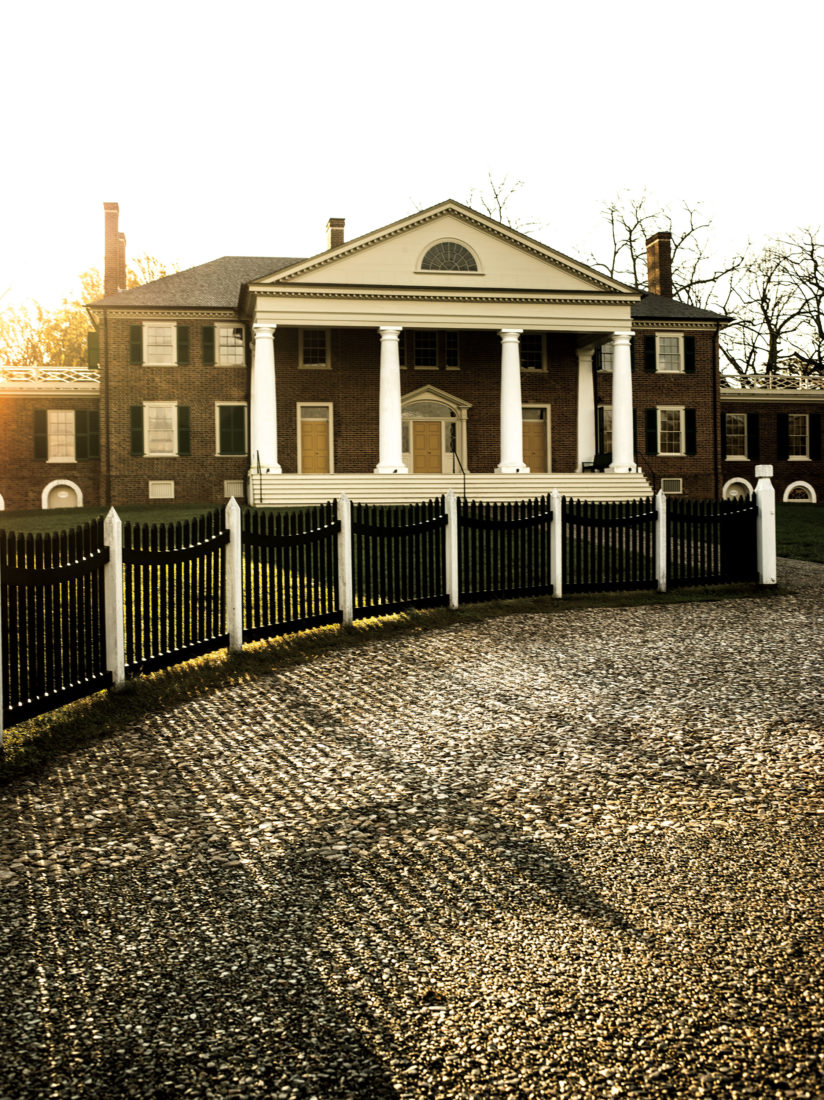
Photo: Bill Phelps
Montpelier’s main house.
“They would ask, ‘How do you think African Americans would feel’ about this or that,” says Coleman, a petite woman who is now in her mid-seventies. “I always told them, I can only speak for myself. I don’t speak for all African Americans. Because we have all had different experiences.” Coleman’s collaboration with the estate proved crucial; she cofounded the Orange County African-American Historical Society, an organ through which Montpelier involved the community. With Coleman’s aid, other Montpelier descendants were invited to take part in the restoration of the Gilmore cabin, which reopened in 2005.
Early on, Montpelier’s leadership took a more progressive view than many historic sites of who should be considered a “descendant” of the estate in the first place. They decided to throw open the doors not only to those with documented genetic ties, but also to those whose ties were born of oral histories—though many of the people enslaved at Montpelier were literate, records were still sparse before the 1870 census. In addition, Montpelier counted those with ties to other former plantations in the area; after all, it was not uncommon for enslaved family members to be married across properties, or to be torn apart, sold to other masters. That inclusivity began to shape every major decision Montpelier made—a level of descendant engagement rare for historic estates.
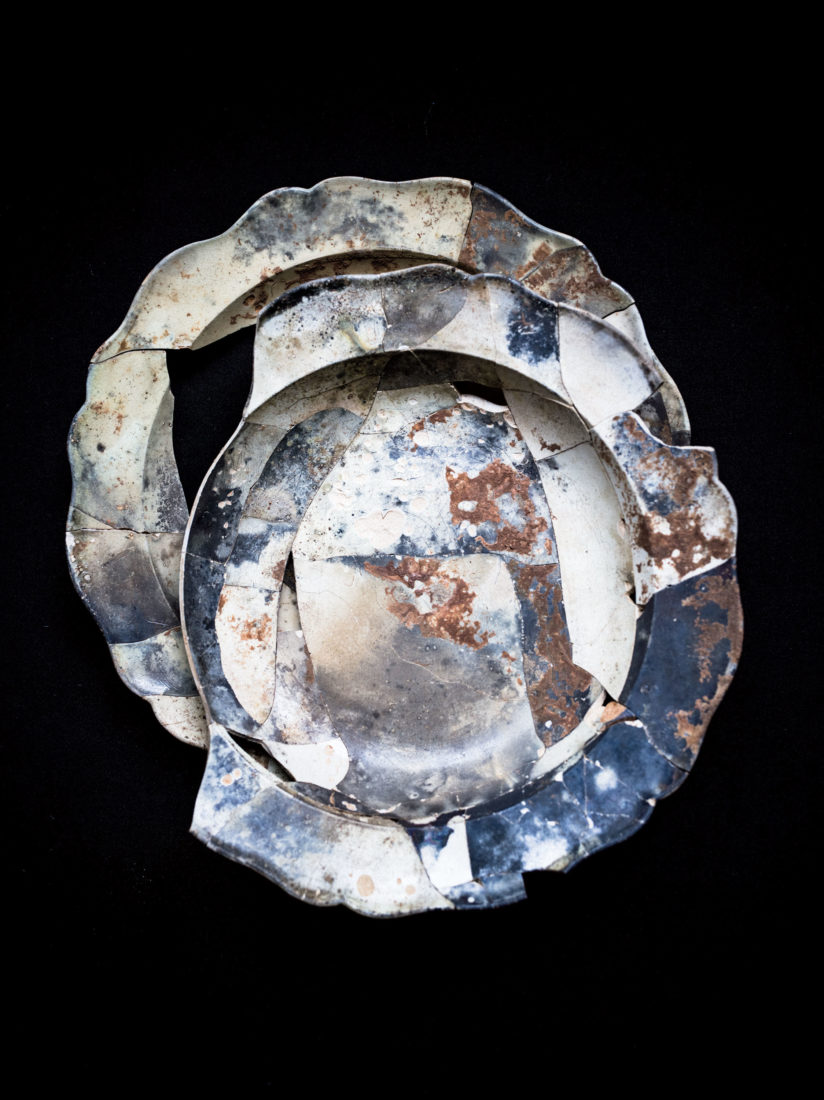
Photo: Bill Phelps
Creamware plates found in the South Yard.
“From me, they get an A-plus,” says Leni Sorensen, a culinary historian who worked on projects at both Thomas Jefferson’s Monticello and Madison’s estate. “Montpelier has brought in local, vocal, bright black activists, historians, and genealogists to tell their story. It can be tedious, but they’ve shown a high level of planning, forethought, and inclusivity.”
Before 2007, Montpelier most likely wouldn’t have earned as high a grade. That year, the main house was in the final stages of renovation. A few descendants were taking a tour of the home when they stepped onto the second-floor terrace, which overlooks the South Yard; there, slabs of wood marked off where the domestic slave quarters had once stood. Iris Ford piped up. A professor of anthropology whose grandfather worked on the estate during the Du Pont era, and whose ancestors were enslaved at a neighboring plantation, Ford turned to Matt Reeves, Montpelier’s director of archaeology and landscape restoration. “Where are my ancestors’ homes?” she asked. “You spent twenty-four million dollars on the Madisons, and all my people get are dead grass and railroad ties?”

Photo: Bill Phelps
The furnished loft of George Gilmore’s cabin.
The question was a wake-up call: Apart from the Gilmore cabin’s revival beyond the estate’s gates, the men and women Madison enslaved were still barely represented. Their stories, and the places where they had lived and worked, had to become as important as the former president’s. Montpelier began fund-raising and applying for grants in order to rebuild the slave quarters and create a new permanent exhibit, inviting the descendant community to weigh in along the way.
And, in some cases, get their hands dirty.
Reeves had been leading on-site public digs called “Expeditions”—now he would expand to the South Yard with the descendants. The Du Ponts’ obsession with horses turned out to be a benefit; the grounds were little farmed during their era, meaning artifacts such as metal tableware, buttons, cooking utensils, and more remained undisturbed beneath the soil—crucial clues as to what life was like for the enslaved.
“You actually expect to get black people back out here, digging in the dirt?” Leontyne Peck once asked Reeves, with a laugh. Peck—a descendant of the Kentucky senator Henry Clay, who often visited his good friend Madison at Montpelier—suggested Reeves emphasize the excavations as a way to connect with family history firsthand. She, for instance, had thrilled when she found a clay pipe during a South Yard dig. Her grandfather William Clay had often smoked pipes, too. “It felt very spiritual to me,” she recalls. “I felt like I was actually touching him. A sign from the ancestors. It almost made me cry.”
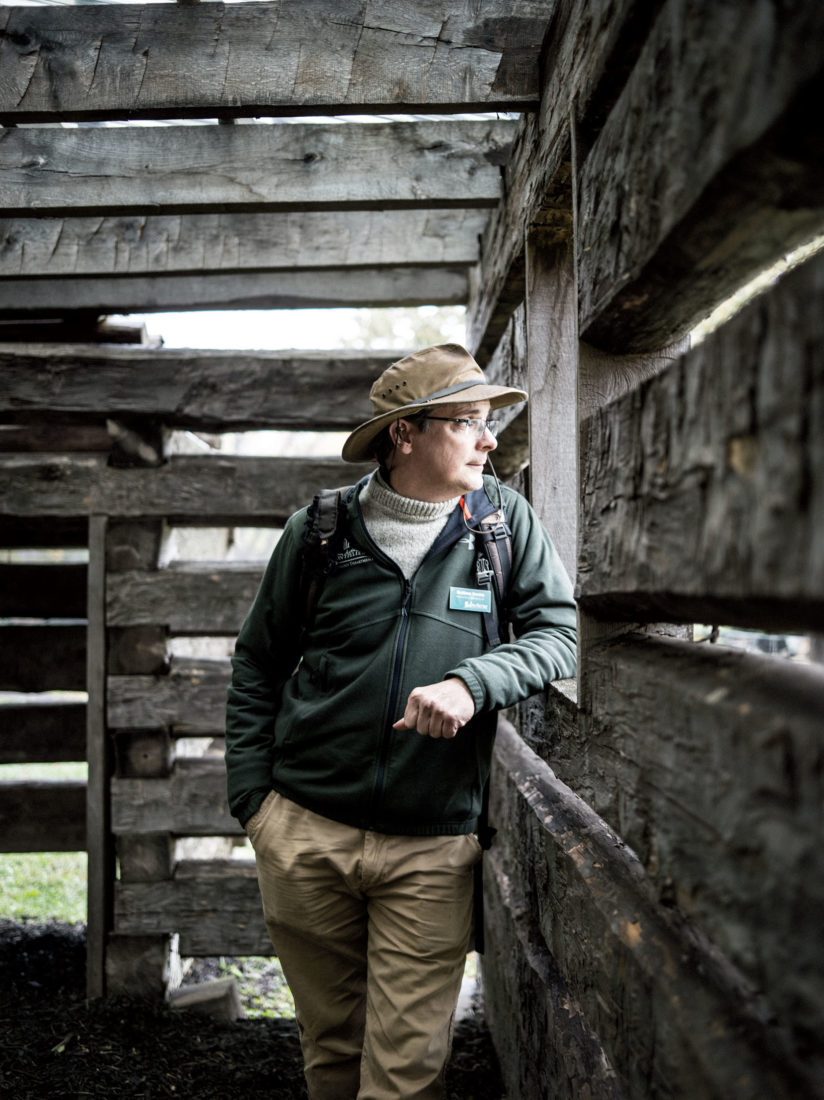
Photo: Bill Phelps
Matt Reeves, Montpelier’s director of archaeology and landscape restoration, in the South Yard’s restored stables.
Montpelier has identified and traced the stories of almost three hundred people enslaved by the Madisons over the generations and, when possible, through genetics and genealogy, connected them to present-day descendants. They also welcome those who claim a blood tie to the former president, although, unlike Thomas Jefferson, for instance, Madison has never been linked to raping his bondwomen. Recently, the estate brought together a white Madison descendant to compare her DNA with that of Bettye Kearse, who had always been told that she descended from the president and a woman he enslaved. The results were inconclusive, but Montpelier is committed to learning the truth, says Elizabeth Ladner, the estate’s director
of research.
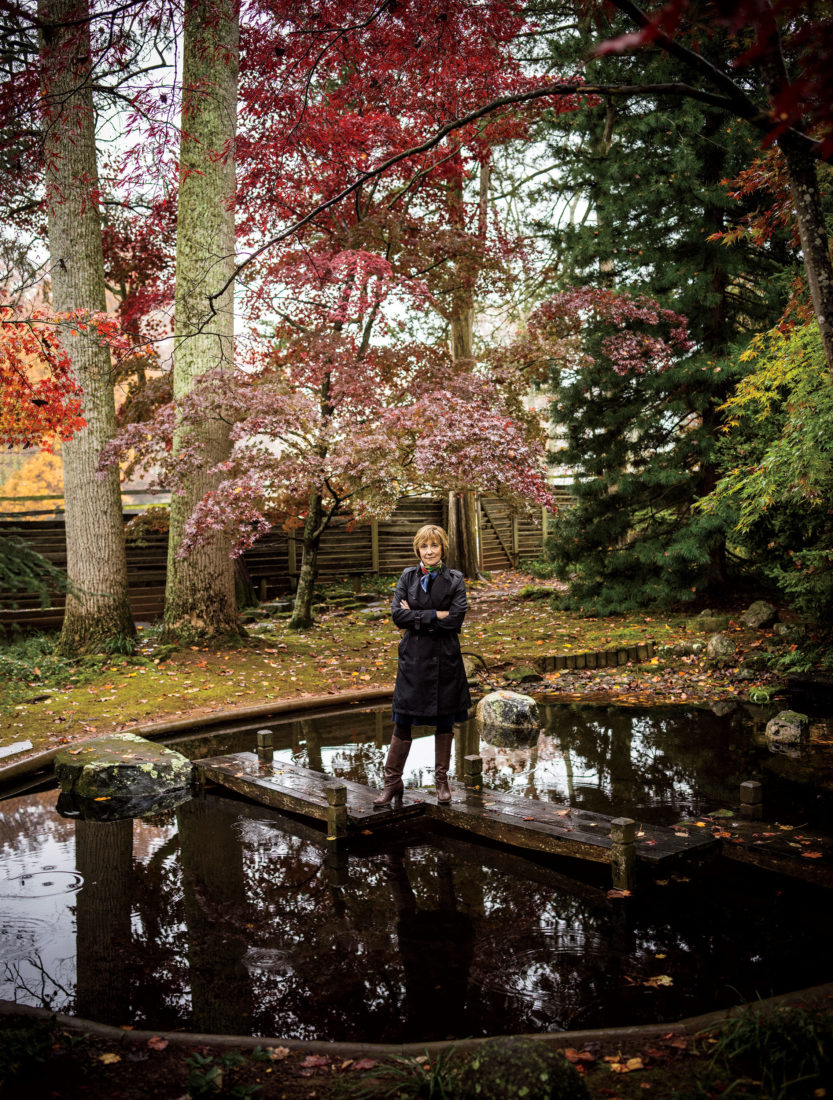
Photo: Bill Phelps
The Montpelier Foundation’s Kim Imhoff, in one of the estate’s many gardens.
That kind of transparency has been embraced by Kat Imhoff, the current CEO and president, since the Montpelier Foundation hired her in 2013. Among other past positions, Imhoff once served as vice president at Monticello. Montpelier’s descendant project intrigued her. “From the beginning, in the eighties, I was looking at these historical sites, and to me, the interesting part was not the big mansions—it was the traces of all these other stories we are just barely seeing now.” When Imhoff joined Montpelier, she knew she had to do three things: take care of the land itself (the property contains the largest old-growth forest in the Virginia Piedmont); finish Madison’s house; and “put more people in the story,” she says. “It can’t just be this one white guy who’s been dead two hundred years.”
David Rubenstein—a billionaire financier who has donated money to the likes of the White House Visitor Center and the Washington Monument repairs—noticed Montpelier’s efforts to move away from what Imhoff calls the “soup tureen” approach to historical interpretation. In 2014, he donated $10 million to the property, a portion of which was used to reconstruct, finally, the slave quarters in the South Yard. Each of the structures, which opened along with the exhibit Mere Distinction last June, tells the story of an enslaved family, a history assembled from documentation, artifacts found on the property, and oral histories.
“I’m interested in all the other people who made this place possible,” Imhoff says. “To make the invisible, visible.” Other founders’ estates have embraced that sentiment, too. In June, for instance, Monticello will open an exhibit based on a twenty-five-year oral history project with the descendants of that estate’s enslaved people. “I wanted to be a part of a place,” Imhoff continues, “that was going to have more of an articulated, complicated, confusing, and complete American story.”
On a weekend last fall, Montpelier teemed with the fruits of that mission.
In the recently renovated and reconstructed cellars of the main house, visitors streamed through Mere Distinction—one of the most striking multimedia exhibits at a founding father’s estate, brimming with images, sounds, interactive displays, and films. The name comes from a Madison quote: “We have seen the Mere Distinction of Colour made in the most enlightened period of time, a ground of the most oppressive dominion ever exercised by man over man.”
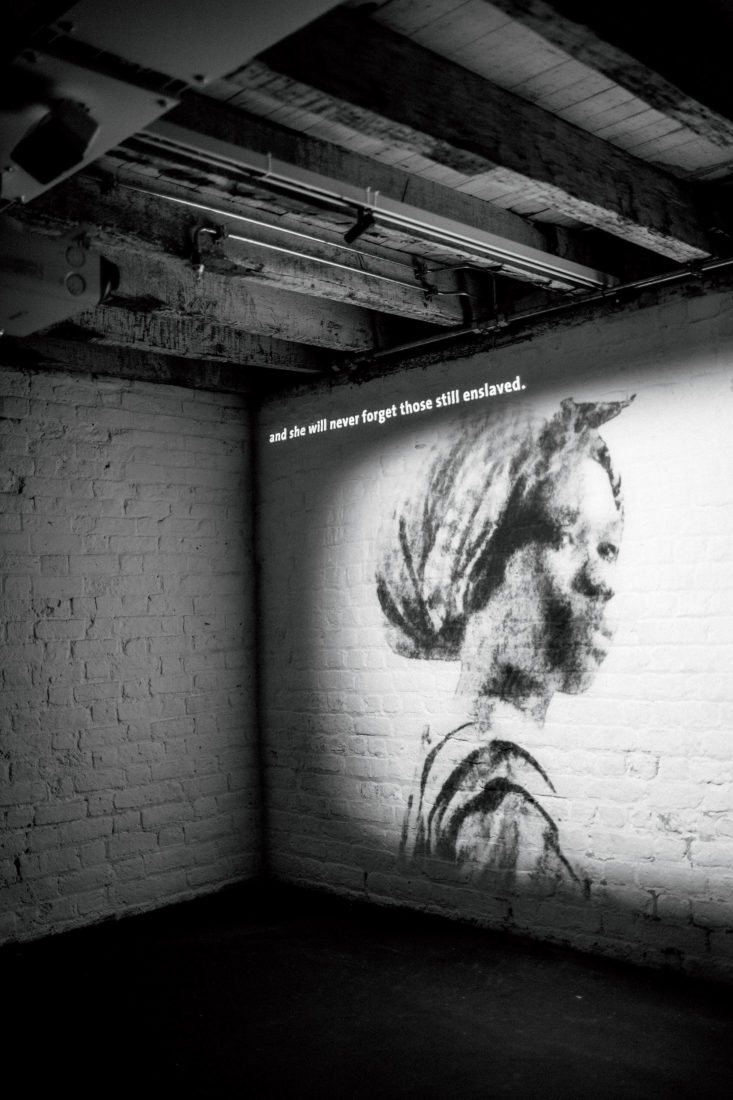
Photo: Bill Phelps
An image of Ellen Stewart from the multimedia exhibit The Mere Distinction of Colour.
That oppression takes center stage here. One of the memorable documentaries not only details the lives of the plantation’s enslaved men and women and the contradictions inherent in Madison’s reputation, but also brings the echoes of slavery to the present—something the descendants specifically requested when Montpelier solicited their opinions. In the film, comments and observations by some of those descendants mix with images of activists such as Frederick Douglass, Martin Luther King, Jr., the Student Non-Violent Coordinating Committee, the Black Panthers, and Black Lives Matter. At one point, the lilting voice of Coleman—whose ancestor George Gilmore was said to have had light skin and blue eyes—rings out: “And how did they become lighter? Because most of the time, if, well—they were raped. And we ended up with these different shades of African Americans.”
Such brutal honesty permeates the exhibit, which also drew from documents such as Paul Jennings’s memoir and letters written by the enslaved population. A massive visual display posts the myriad notices Madison published advertising rewards for runaway slaves—“TWENTY DOLLAR REWARD: Runaway the 14th of June…a Mulatto Slave, named ANTHONY, about 17 years old, low, but well made.” A table highlights the sentences written by Madison in the Constitution, codifying slavery. An audio show reveals the tale of an enslaved woman who runs off to join a rebellion, and who is sold once recovered.
And an animated short film relays the heartbreaking story of Ellen Stewart, whose mother, Sukey, Dolley Madison’s personal maid, was sold away.
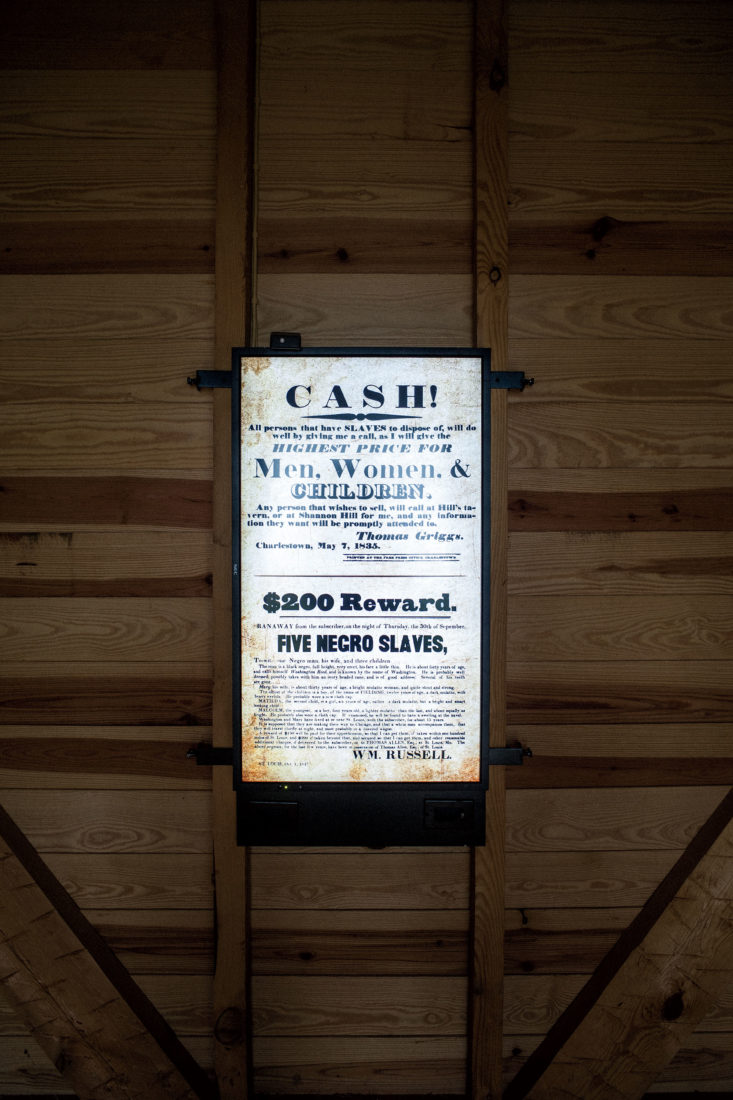
Photo: Bill Phelps
A notice for escaped slaves posted by James Madison, displayed in the South Yard’s smokehouse.
“Some people walk in and walk out right away, clearly uncomfortable,” says Imhoff, who has also received emails from people disturbed by the exhibit. “As the man says in the Mere Distinction documentary, ‘We really don’t like history, we like nostalgia.’ I’m dealing with people’s grief. Not just African American grief, but white people’s grief—‘This isn’t the story we like!’ But what I’m really impressed by are the people who say with tears in their eyes, I’m so pleased to see a museum that is not just about the shiny album. We love the fact that a place like this is going to tell the whole story.”
That story leads back to the Gilmore cabin, the whitewashed home now fully restored and furnished and a part of the Montpelier experience. “Some folks can trace their roots,” Coleman says. “But to actually walk into the home?” All these years later, “it still gives me such a feeling,” she says, “as though I’m representing [my ancestors’] presence here.”
These efforts have attracted other groups, too—including, this same fall weekend, Joseph McGill’s Slave Dwelling Project. McGill, a military veteran and history consultant at Magnolia Plantation in Charleston, South Carolina, organizes overnight stays in the surviving or re-created quarters of the enslaved, “to deliver the message,” he has said, “that the people who lived in these structures were not a footnote in American history.” This time, he drew forty or so people to Montpelier to rough it for a sleepover in the reconstructed slave structures—sleeping bags, pillows, fireplace heat. The participants circled a massive roaring campfire between the white wooden homes, and as the smoke wafted up into the chill October air, they began to introduce themselves and to share stories. Marvin-Alonzo Greer, a historical interpretation supervisor at Williamsburg at the time, came on the tour out of professional curiosity, only to discover he might be a genetic descendant. “It blew my mind,” he said.
A young woman pulled a blanket closer around her shoulders. “My family only knew that some of our ancestors lived near here, but not that they worked”—enslaved—“at Montpelier,” she said. “I feel a connection to this place that I find difficult to express.” The group murmured in understanding. Then she shared a thought—a sentiment that Montpelier’s descendant community made possible.
“I feel the ancestors are here with us.”


